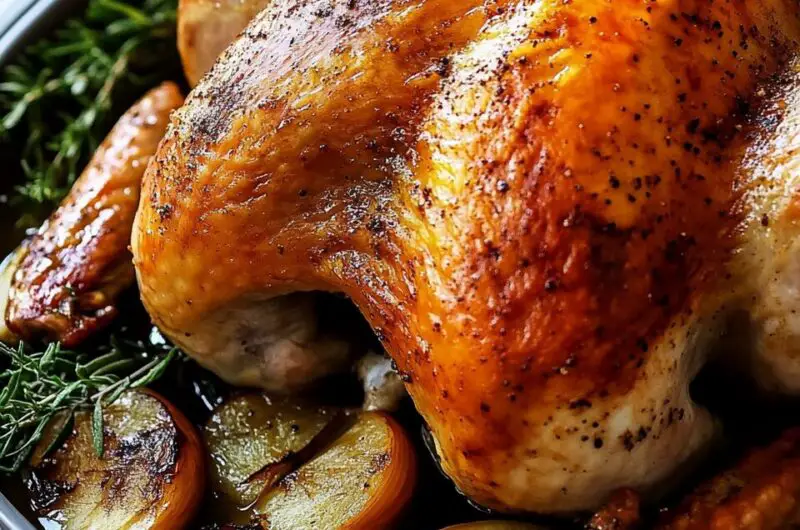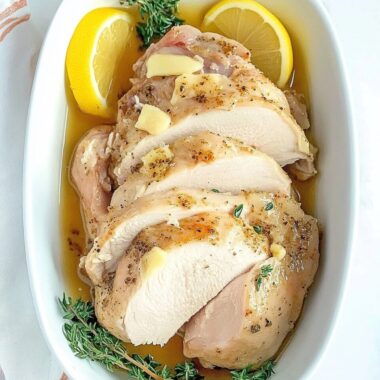The secret to the juiciest, most flavorful turkey you’ve ever had? Brining. This recipe walks you through every step of how to properly brine a turkey using a delicious mix of citrus, herbs, and spices. The result? A tender, perfectly seasoned turkey that’s a showstopper for any holiday table. Once brined, the turkey is roasted to golden perfection with a simple butter rub and a touch of seasoning that enhances every bite. Whether you’re hosting a traditional Thanksgiving dinner or just love an impressive poultry centerpiece, this recipe guarantees moist meat and crispy skin every time. Your guests will rave, and you’ll wonder why you ever skipped the brine!
Full Recipe:
Ingredients:
For the Brine:
-
1 gallon water
-
1 cup kosher salt
-
1/2 cup brown sugar
-
1 tablespoon whole black peppercorns
-
1 tablespoon whole allspice berries
-
4 bay leaves
-
1 tablespoon dried rosemary
-
1 tablespoon dried thyme
-
4 cloves garlic, smashed
-
1 large onion, sliced
-
Zest of 1 orange
-
Zest of 1 lemon
-
1 gallon ice water
For the Turkey:
-
1 whole turkey (12–14 lbs), thawed if frozen
-
4 tablespoons unsalted butter, softened
-
1 tablespoon olive oil
-
1 teaspoon ground black pepper
-
1 teaspoon paprika
-
Fresh herbs (rosemary, thyme, sage), optional for cavity
-
1 onion, quartered
-
1 apple, quartered
-
4 cloves garlic
Directions:
-
In a large stockpot, combine 1 gallon of water with the salt, brown sugar, spices, herbs, garlic, onion, and citrus zest. Bring to a boil, stirring until salt and sugar are dissolved.
-
Remove from heat and let the brine cool completely. Add 1 gallon of ice water to cool it faster.
-
Place the thawed turkey in a large brining bag or food-safe container. Pour in the brine, ensuring the bird is fully submerged. Seal or cover and refrigerate for 12–24 hours.
-
After brining, remove the turkey from the liquid, rinse under cold water, and pat dry thoroughly with paper towels.
-
Preheat the oven to 325°F (165°C).
-
Rub the turkey with softened butter and olive oil. Season with black pepper and paprika.
-
Stuff the cavity with optional fresh herbs, onion, apple, and garlic.
-
Place the turkey breast-side up on a roasting rack inside a large roasting pan. Roast uncovered for approximately 15 minutes per pound, or until a meat thermometer reads 165°F (74°C) in the thickest part of the thigh.
-
Let the turkey rest for at least 20 minutes before carving to retain juices.
Prep Time: 30 minutes (plus brining time) | Cooking Time: 3.5–4 hours | Total Time: ~28 hours (with brine)
Kcal: 480 kcal | Servings: 12 servings
How to Brine and Roast a Turkey for the Juiciest Holiday Centerpiece
Roasting a whole turkey is one of the most iconic traditions during Thanksgiving and other festive gatherings. Yet, despite its popularity, many home cooks still struggle with one common challenge dry turkey meat. If you’ve ever experienced disappointment after hours of roasting only to slice into a bland or dry bird, you’re not alone. The good news? Brining is the game-changing technique that can guarantee moist, flavorful turkey every time.
In this article, we’ll dive into the reasons why brining works so well, how to approach it with confidence, and what makes a brined and roasted turkey not just a holiday dish, but a celebration in itself.
What is Brining?
Brining is a technique that involves soaking meat in a solution of water and salt, often enhanced with sugar, herbs, spices, and citrus. The process might seem simple, but its science is profound. The salt in the brine breaks down some of the muscle proteins in the turkey, allowing it to absorb more liquid and retain it during cooking. This not only makes the turkey juicier, but it also enhances its flavor from the inside out.
Unlike marinating, which affects only the outer layer of meat, brining penetrates deep into the turkey’s flesh. A 12-14 pound bird brined properly can absorb nearly 10% of its weight in seasoned water, transforming it into a moist, flavorful masterpiece by the time it comes out of the oven.
Why Brine a Turkey?
1. Unmatched Moisture Retention
Turkey breast meat is notorious for drying out because it cooks faster than the dark meat on the legs and thighs. Brining helps prevent this by increasing the turkey’s moisture content before it ever enters the oven.
2. Even Flavor Distribution
Traditional seasoning often sits on the surface, but brining allows for flavor to reach every fiber of the turkey. Adding aromatics like garlic, herbs, and citrus peels elevates the depth and complexity of flavor, infusing each bite with savory goodness.
3. Stress-Free Roasting
Because brined turkey retains more liquid during cooking, it’s a lot more forgiving in the oven. Even if it roasts a bit longer than intended, the meat will still be juicy and tender.
Wet Brine vs. Dry Brine: What’s the Difference?
There are two common types of brining methods: wet and dry. This recipe uses a wet brine, which involves submerging the turkey in a liquid solution. A dry brine involves rubbing salt (and sometimes sugar or spices) directly onto the turkey’s skin and letting it rest uncovered in the fridge for a longer period.
Both methods have their merits, but wet brining tends to deliver more moisture, which is especially beneficial for lean meats like turkey. The water-based solution creates an environment where both seasoning and moisture are deeply absorbed.
Choosing the Right Turkey
When brining a turkey, start with a fresh or completely thawed bird. Avoid self-basting or pre-brined turkeys, which may already contain salt solutions that can lead to overly salty results. Look for labels that say “natural” or “no added ingredients.”
For a 12–14 pound turkey, you’ll need at least 2 gallons of brine, and sufficient fridge space or a large cooler to hold the turkey submerged for 12–24 hours.
Flavor Enhancements for the Brine
While salt and water form the foundation of a wet brine, the addition of herbs, spices, citrus zest, and aromatics truly sets your turkey apart. Common flavorings include:
-
Garlic for pungency and depth
-
Peppercorns and allspice for warmth and spice
-
Bay leaves and thyme for earthy notes
-
Orange and lemon zest for brightness
-
Brown sugar to balance the saltiness and promote caramelization
These elements infuse the turkey with subtle layers of flavor, enhancing its natural savoriness without overpowering it.
Proper Brining Technique
Success in brining comes down to time, temperature, and technique.
-
Time: Aim for at least 12 hours, but no more than 24. Brining too long can result in overly salty or mushy meat.
-
Temperature: The brine and turkey must remain cold (below 40°F) to prevent bacterial growth. If refrigerator space is limited, a food-safe cooler filled with ice works just as well.
-
Drying: After brining, rinse the turkey thoroughly and pat it dry. Letting it rest uncovered in the fridge for a few hours helps the skin dry out, which leads to better browning and crispiness during roasting.
The Perfect Roast
Once the turkey is brined and dried, it’s ready for the oven. A simple butter and olive oil rub with a light seasoning of black pepper and paprika is all you need. You’ll notice that salt is excluded thanks to the brine, your turkey is already perfectly seasoned.
Stuff the cavity with aromatics like fresh herbs, apple slices, garlic, and onion to further perfume the meat and elevate the roasting experience. As the turkey cooks, the fat from the butter helps the skin turn golden brown while basting the bird from within.
Roast your turkey at 325°F (165°C) and use a meat thermometer to ensure accuracy. The turkey is done when the thickest part of the thigh reaches 165°F (74°C). Let it rest for at least 20 minutes before carving, allowing juices to redistribute throughout the meat.
Advertisement
Serving Suggestions
A brined turkey pairs beautifully with both traditional and modern sides. Consider serving it with:
-
Classic stuffing or wild rice pilaf
-
Roasted Brussels sprouts or green bean almondine
-
Mashed or sweet potatoes
-
Cranberry orange relish or spiced chutney
-
Homemade gravy using the flavorful turkey drippings
Leftovers make incredible sandwiches, soups, or casseroles another reason to be generous with your bird size!
Conclusion:
Brining a turkey may add a few extra steps to your prep, but the rewards are undeniably worth it. Moist, juicy meat, rich with flavor from herbs and spices, and golden, crispy skin that’s the promise of a well-brined turkey. Whether you’re preparing Thanksgiving dinner or simply enjoying a holiday meal with loved ones, this method is a foolproof way to impress your guests and elevate your culinary confidence.








